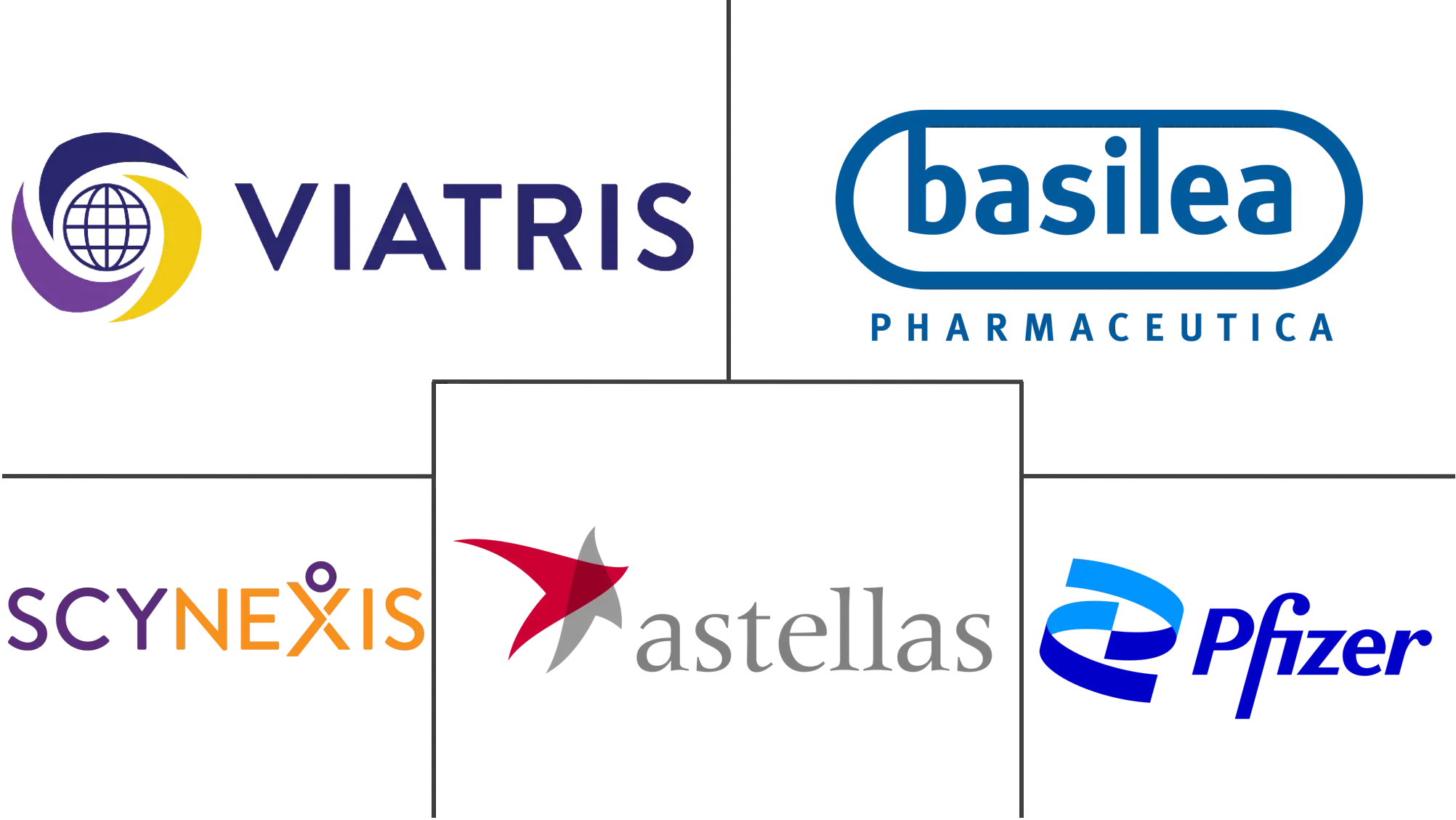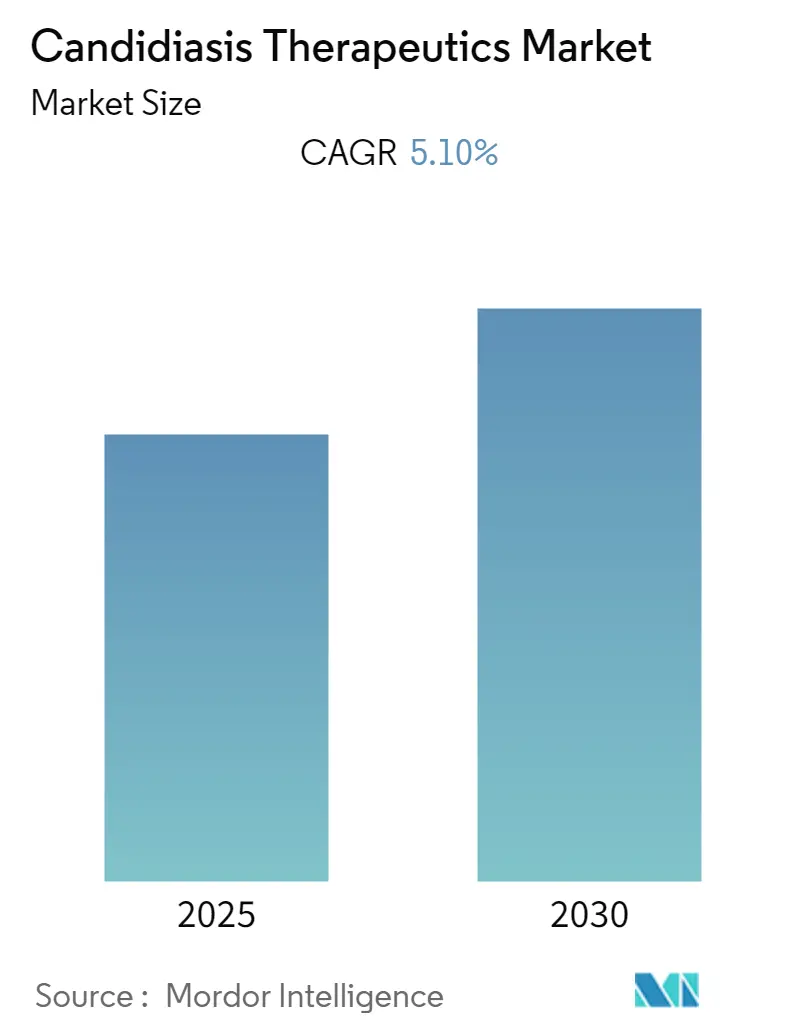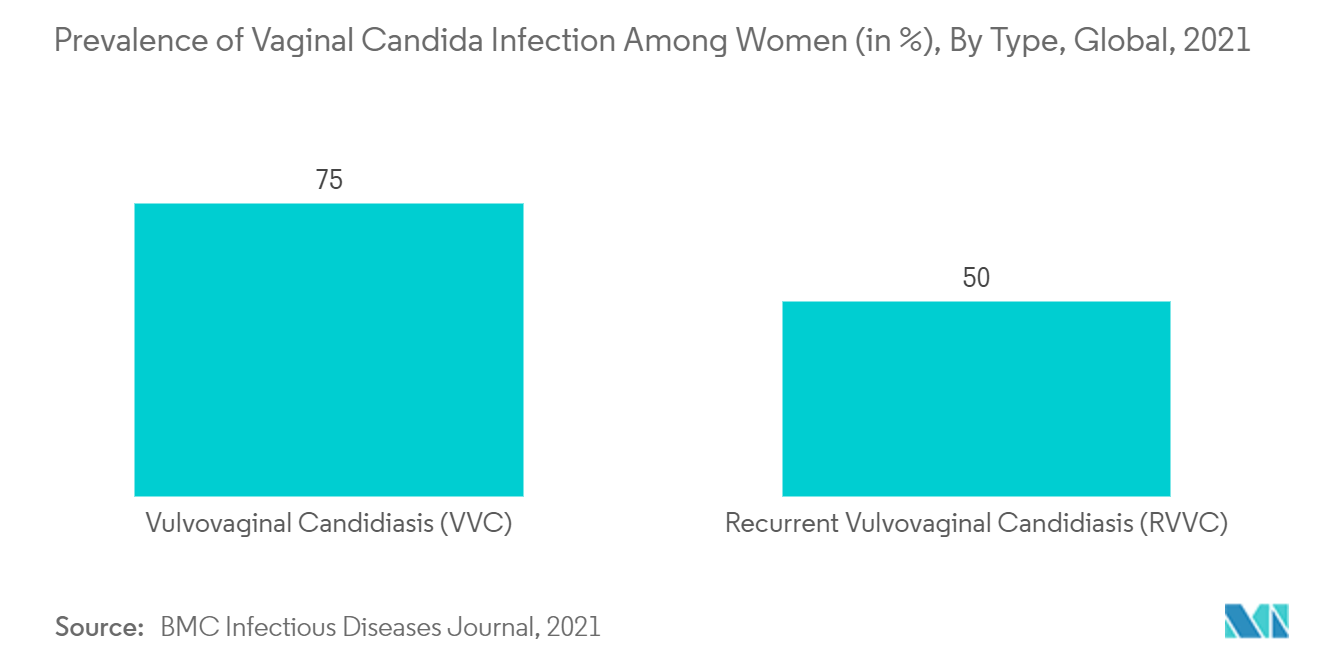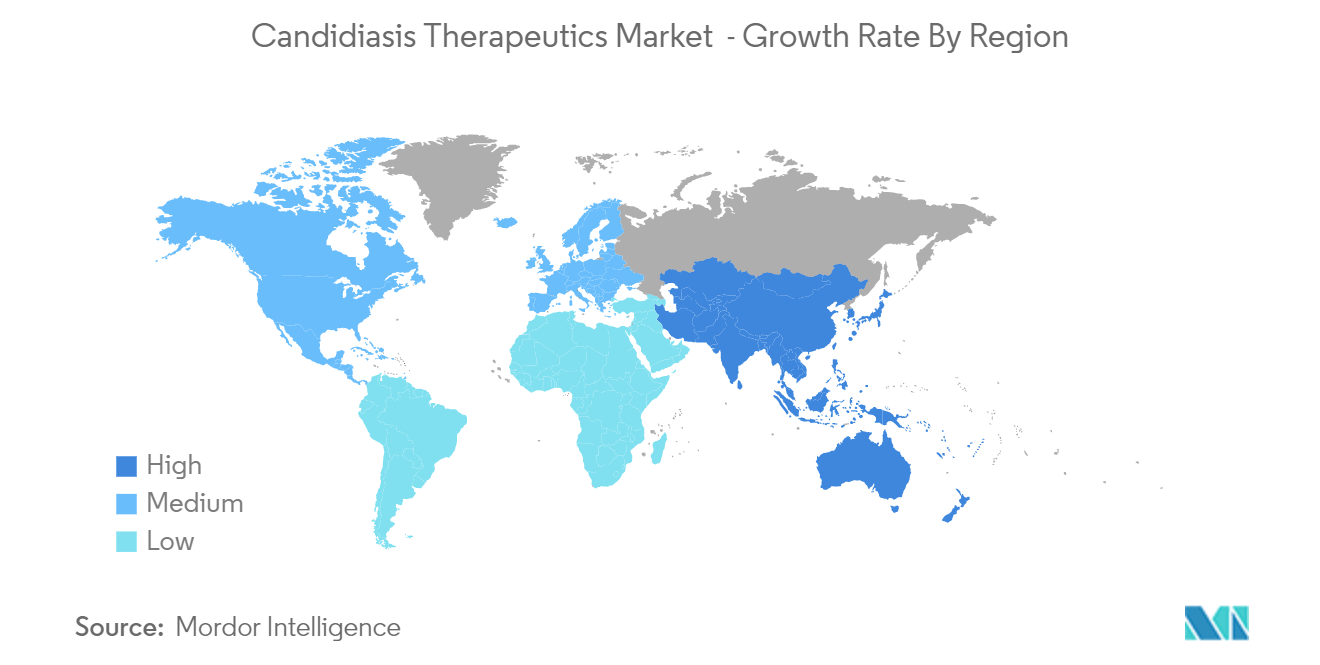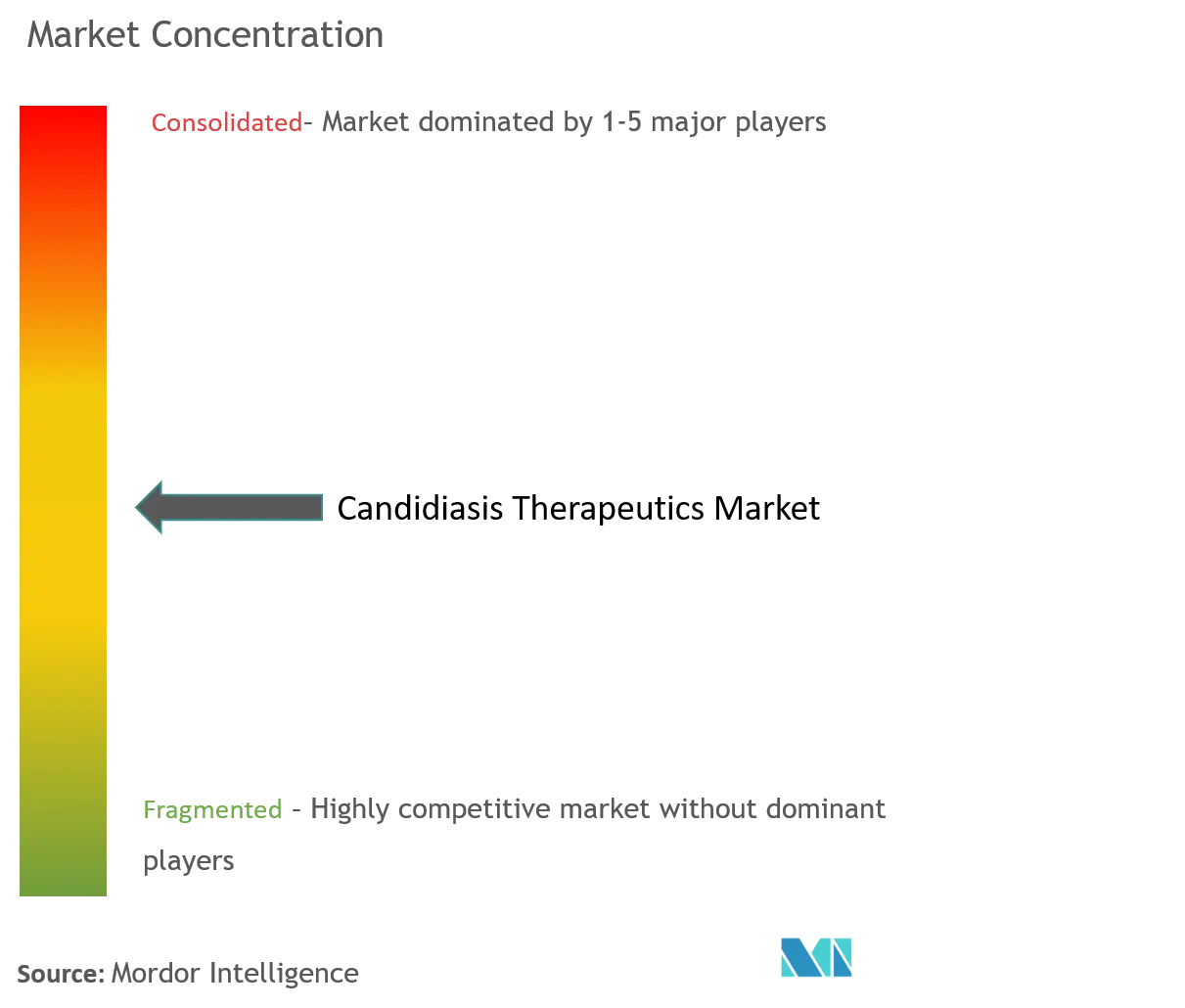Candidiasis Therapeutics Market Analysis
The Candidiasis Therapeutics Market is expected to register a CAGR of 5.1% during the forecast period.
The COVID-19 pandemic impacted the market studied significantly in the initial phase. Due to the lockdown and shutdowns, global trade was affected drastically, and the supply chain of pharmaceuticals was disrupted, which hampered the sales of candidiasis drugs and therapeutics. However, even though the market initially showed a decline in sales, the increasing number of infections during the pandemic phase increased the demand for candidiasis therapies. Fungal co-infections were found along with COVID-19 infections. For instance, according to an article published by PubMed Central in March 2022, COVID-19-associated candidiasis was widely recognized as a part of severe COVID-19 consequences during the pandemic. The article also stated that factors responsible for the co-infection were a compromised immune system, iron and zinc deficiencies, and nosocomial and iatrogenic transmissions. Thus, the demand for innovative therapies increased for candidiasis infection during the pandemic. However, in the post-pandemic period, the market studied is expected to have stable growth during the forecast period.
Furthermore, the growing prevalence of candidiasis infection is further driving the demand for new therapeutics for treatment, augmenting the market's growth. The global burden of candida infection is currently rising. For instance, among all the other countries globally, Zimbabwe is one of the major countries affected by several healthcare challenges. According to an article by Nature in June 2021, the estimated prevalence of recurrent vulvovaginal candidiasis (RVVC) was 2,739/100,000 in Zimbabwe, and the estimated burden is high compared to other African countries. These prevalent cases of candidiasis in low-income countries like Zimbabwe and others are creating demand for the availability of better and more advanced therapeutics, which in turn is expected to impact the growth of the market studied.
Moreover, candidiasis in the mouth or oral candidiasis is one of the most common infections affecting most of the population globally. The persistent oral infection among the population requires treatment to combat the spread of the infection, further boosting the growth of the market studied. An article updated in the National Library of Medicine in March 2022 reported that oral candidiasis can occur in immunocompetent or immunocompromised patients. But this is more common in immunocompromised hosts. This oral candidiasis occurs equally in males and females, typically in neonates and infants. The global burden of candidiasis is growing with the rising population globally. Hence, the therapeutics for candidiasis have become more critical. Therefore, the burden of oral candidiasis is expected to drive the market for candidiasis therapeutics in the future.
In addition, the growing awareness of candidiasis infection among the target population and product innovation in all market segments are driving the demand for new therapeutics. For instance, in September 2021, Cidara Therapeutics, Inc., a biotechnology company developing long-acting therapeutics designed to improve the standard of care for patients facing serious diseases, presented new clinical and non-clinical data for its Rezafungin in two poster presentations at the 10th Congress on Trends in Medical Mycology (TIMM) Webinar which took place in Aberdeen, Scotland. Rezafungin is a novel once-weekly echinocandin which is being developed for both the treatment and prevention of serious fungal infections, such as candidemia and invasive candidiasis. Hence, product innovation is expected to boost the market growth.
Therefore, the studied market is predicted to see growth over the forecast period owing to the aforementioned factors. However, narrow pipeline molecules and competition from herbal medicines and alternative therapies can hinder the market growth.
Candidiasis Therapeutics Market Trends
Vulvovaginal Candidiasis Segment is Expected to Hold a Significant Share in the Market
Vulvovaginal candidiasis (VVC) is a vaginal fungal infection confirmed to be caused by Candida species. In most cases, it is caused by Candida albicans. The VVC can be caused by other Candida species or yeasts occasionally. VVC is also called recurrent vulvovaginal candidiasis (RVVC) because it is a relapsing vaginal fungal infection. The high prevalence of infection among the population is driving the segment growth; thus, the vulvovaginal candidiasis segment is predicted to see growth in the future.
Increasing research to find the prevalence of the VVC or RVVC is also expected to boost segment growth. According to a research article published by PubMed in August 2021, the prevalence of recurrent vulvovaginal candidiasis (RVVC) varies owing to the age of the population. It can be as high as 9%. Due to the lack of treatment options in 57% of the cases, relapses occur within six months after fluconazole maintenance therapy, which is the most commonly used treatment among other options.
Furthermore, a research article published by PLOS One in April 2022 reported that vaginitis is a common complaint in the outpatient setting and candida species cause approximately 30% of vaginitis episodes, with an estimated 75% of women affected by vulvovaginal candidiasis (VVC) during their lifetimes. Thus, the high prevalence of the infection among the target population requires more attention and therapeutics for treatment. This drives the growth of the segment.
Additionally, the segment's research & development (R&D) is increasing. Major players are focusing on developing products for vaginal yeast infection, which, in turn, is predicted to drive segment growth. For instance, in February 2021, SCYNEXIS, Inc., a biotechnology company focused on developing therapies and drugs for fungal infections, partnered with Amplity Health, one of the global leaders in contract commercialization organization, to launch Brexafemme (ibrexafungerp) in the United States. Brexafemme is the expected trade name for ibrexafungerp, an oral antifungal product candidate for the treatment of vulvovaginal candidiasis (VVC), also known as a vaginal yeast infection. In April 2022, Mycovia Pharmaceutical's new product, VIVJOA (oteseconazole), received FDA approval and became the only FDA-approved medication for recurrent vulvovaginal candidiasis (RVVC) or chronic yeast infection. Thus, the increasing R&D in the segment is anticipated to drive segment growth.
Therefore, such factors mentioned above are anticipated to drive the segment growth, which is expected to propel the overall market growth over the forecast period.
North America is Expected to Hold a Significant Market Share Over the Forecast Period
North America is expected to hold a significant market share owing to the increasing target population in the countries across the region.
Increasing research and product development in the United States is expected to boost market growth in the region. For instance, according to an article published by PubMed in April 2022, a research study aimed to calculate rates and evaluate diagnosis and treatment practices of vulvovaginal candidiasis (VVC) and recurrent vulvovaginal candidiasis (RVVC) in the United States was conducted. The study was conducted using IBM MarketScan, including health insurance claims data on outpatient visits and prescriptions for 28 million people. The study results showed that among 12.3 million female patients in the IBM MarketScan database, 149,934 had a diagnosis code for VVC. Among those, 3.4% had RVVC. The VVC rate was highest in the South census region (14.3 per 1,000 female patients). Thus, the prevalence of vaginal candidiasis generates demand for new therapeutics in the country, driving market growth.
Additionally, research & development activities regarding candidiasis in Canada is also enhancing the segment growth. For instance, according to clinicaltrials.gov, in June 2021, a phase 1 study was started by the University of Manitoba, Canada, to check the efficacy of fluconazole and boric acid in vulvovaginal candidiasis patients.
In addition, the major players are engaged in innovation and product development in the country, which is garnering the market studied growth in the country. For instance, in November 2021, Profounda, Inc., a United States Bases company, received the FDA's Orphan Drug Designation approval for using miltefosine to treat Invasive candidiasis with Miltefosine. Thus, the recent developments in the United States are predicted to drive the overall growth of the market studied in the region.
Therefore, owing to the previously mentioned factors, the growth of the studied market is expected in the North American region.
Candidiasis Therapeutics Industry Overview
The Candidiasis Therapeutics market is competitive and consists of several major players. In terms of market share, a few major players dominate the market. Some prominent players launch new products, while others engage in product development and clinical trials. The competitive landscape includes an analysis of several companies which hold most of the market shares and are well known. Basilea Pharmaceutica Ltd, Astellas Pharma Inc., SCYNEXIS, Inc., NovaDigm Therapeutics, Mycovia Pharmaceuticals, Inc., Pfizer Inc, and Viatris Inc., among others.
Candidiasis Therapeutics Market Leaders
-
Basilea Pharmaceuticals
-
Astellas
-
SCYNEXIS, Inc.
-
Pfizer Inc.
-
Viatris Inc.
- *Disclaimer: Major Players sorted in no particular order
Candidiasis Therapeutics Market News
- September 2022- Cidara Therapeutics, Inc. announced that the United States FDA has accepted filing and granted priority review to its New Drug Application (NDA) for rezafungin for the treatment of candidemia and invasive candidiasis.
- September 2022- SCYNEXIS, Inc. presented positive interim data in patients with refractory candidiasis treated with oral ibrexafungerp from the ongoing Phase 3 FURI study and data from the ongoing CARES study of patients with Candida auris infections.
Candidiasis Therapeutics Industry Segmentation
According to the scope of the report, candidiasis is a fungal infection that affects both men and women of all age groups. It is also known as candidosis, moniliasis, and oidiomycosis. The effects of this infection are seen on a dermal, internal, and systemic level, and is known as candidemia or intestinal thrush.
The Candidiasis Therapeutics Market is segmented by Route of Administration (Injection, Ointment, and Oral), Drug Type (Polyene, Azole, Echinocandin, and Other Drug Types), Anatomy Type (Oral Candidiasis, Vulvovaginal Candidiasis, Cutaneous Candidiasis, Invasive Candidiasis, and Systemic Candidiasis), End-users (Hospitals and Clinics, Retail Pharmacies, and Other End-users), and Geography (North America (United States, Canada, and Mexico), Europe (Germany, United Kingdom, France, Italy, Spain, and Rest of Europe), Asia-Pacific (China, Japan, India, Australia, South Korea, and Rest of Asia-Pacific), Middle East and Africa (GCC, South Africa, and Rest of Middle East and Africa), and South America Brazil, Argentina, and Rest of South America)). The report offers the value (in USD million) for the above segments.
| By Route of Administration | Injection | ||
| Ointment | |||
| Oral | |||
| By Drug Type | Polyene | ||
| Azole | |||
| Echinocandin | |||
| Other Drug Types | |||
| By Anatomy Type | Oral Candidiasis | ||
| Vulvovaginal Candidiasis | |||
| Cutaneous Candidiasis | |||
| Invasive Candidiasis | |||
| Systemic Candidiasis | |||
| By End-user | Hospitals and Clinics | ||
| Retail Pharmacies | |||
| Other End-users | |||
| Geography | North America | United States | |
| Canada | |||
| Mexico | |||
| Europe | Germany | ||
| United Kingdom | |||
| France | |||
| Italy | |||
| Spain | |||
| Rest of Europe | |||
| Asia-Pacific | China | ||
| Japan | |||
| India | |||
| Australia | |||
| South Korea | |||
| Rest of Asia-Pacific | |||
| Middle East and Africa | GCC | ||
| South Africa | |||
| Rest of Middle East and Africa | |||
| South America | Brazil | ||
| Argentina | |||
| Rest of South America | |||
Candidiasis Therapeutics Market Research FAQs
What is the current Candidiasis Therapeutics Market size?
The Candidiasis Therapeutics Market is projected to register a CAGR of 5.1% during the forecast period (2025-2030)
Who are the key players in Candidiasis Therapeutics Market?
Basilea Pharmaceuticals, Astellas, SCYNEXIS, Inc., Pfizer Inc. and Viatris Inc. are the major companies operating in the Candidiasis Therapeutics Market.
Which is the fastest growing region in Candidiasis Therapeutics Market?
Asia-Pacific is estimated to grow at the highest CAGR over the forecast period (2025-2030).
Which region has the biggest share in Candidiasis Therapeutics Market?
In 2025, the North America accounts for the largest market share in Candidiasis Therapeutics Market.
What years does this Candidiasis Therapeutics Market cover?
The report covers the Candidiasis Therapeutics Market historical market size for years: 2021, 2022, 2023 and 2024. The report also forecasts the Candidiasis Therapeutics Market size for years: 2025, 2026, 2027, 2028, 2029 and 2030.
Our Best Selling Reports
Candidiasis Therapeutics Industry Report
Statistics for the 2025 Candidiasis Therapeutics market share, size and revenue growth rate, created by Mordor Intelligence™ Industry Reports. Candidiasis Therapeutics analysis includes a market forecast outlook for 2025 to 2030 and historical overview. Get a sample of this industry analysis as a free report PDF download.

